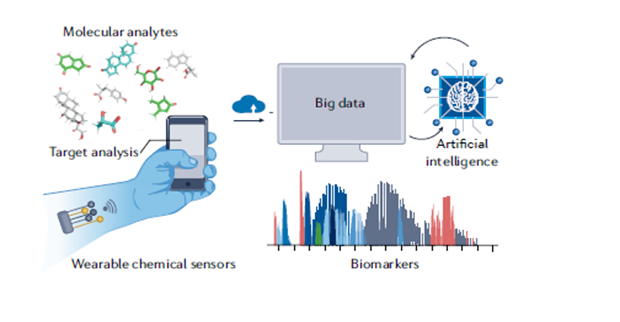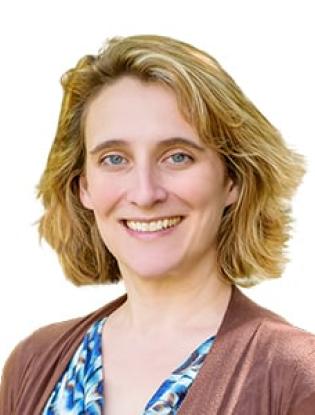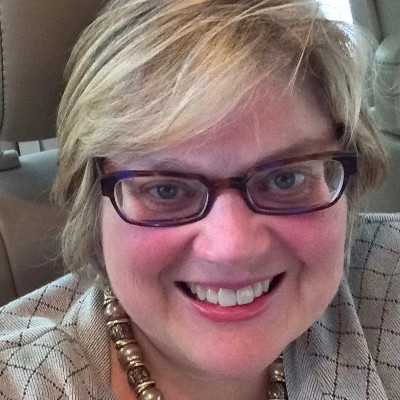One Day, Prep for Stem Cell Transplants May Be at Home
This is the second in a series of in-depth articles about research aimed at Improving Access to Cancer Care for Personalized Medicine led by American Cancer Society (ACS) staff or funded scientists.
Part II: Sweat Sensors
ACS grantee tests a sweat sensor to see if it quickly IDs a personalized dose for 2 chemotherapy drugs that AML patients receive before a stem cell transplant.

Wearable chemical sensors analyze sweat to look for biomarkers, providing a real-time, non-invasive alternative to typical laboratory blood analysis. These devices may allow for remote at-home personalized health monitoring and substantially reduce healthcare costs.
Wei Gao, PhD, a biomedical engineer at Cal Tech in Pasadena and current American Cancer Society (ACS) Research Scholar, has been rocking the medical engineering world for the past 7 years or so. Gao’s team focuses on biosensor technology and other synthetic micro- and nano-bioelectronic medical devices.

In Plain Words
Want to better understand precision medicine, pharmacokinetics, or the Internet of Everything? See Understanding Cancer Research Terms.
His lab’s work on wearable sweat sensors has been featured on the cover of multiple research journals: Science Robotics, Nature Biomedical Engineering, Advanced Material Technologies, to name only a few. The devices he designs and tests are so interesting and game-changing for precision medicine that they’ve also crossed over to consumer publications, like Scientific American, Nature, and Newsweek.
Last year, among his many achievements, he received the Best Rising Star of Science Award (he ranked #6 in the US and #27 in the world), and he even has his own Wikipedia page.
Many people might assume Gao’s success has come from being a digital native and playing with robots and rockets while learning to walk. But Gao says that the small village in China where he was raised didn’t offer such advanced play things—in fact, he didn’t have his first computer until about age 20. He just knew from a young age that he wanted to help people get feedback about their health so they could get help, and he wanted to do it with technology and devices.
His claim to fame is the development of a completely integrated wearable sweat sensor that collects large amounts of biological data on the molecular level without a patient having to get poked for blood or even exercise to produce sweat. He’s been collaborating with other researchers and clinicians to help people who have stress, diabetes, COPD, and now cancer.
“We start the discussion with collaborators by talking about the condition they’re interested in. We ask questions, like ‘What are the targeted biomarkers we need to measure? Are we able to measure them?’ If we cannot get the measurements, we ask ourselves, ‘Can we develop new technology to do it?’ We may start to develop new technology while we keep up the discussions about what the need is, what the desire is, how frequently they need measurements, and other information.
“We start the discussion with collaborators by talking about the condition they’re interested in. We ask questions, like What are the targeted biomarkers we need to measure? Are we able to measure them? If we cannot get the measurements, we ask ourselves, Can we develop new technology to do it?
We may start to develop new technology while we keep up the discussions about what the need is, what the desire is, how frequently they need measurements, and other information.
“At some point, when we have the technology, we give a presentation to our collaborator. Their feedback is very important to us to improve the technology. We also need to work together to validate the technology by taking measurements with the currently used method to ensure the trends are similar. As the technology gets more mature, then our study plans go through IRB [Institutional Review Board, which makes sure research is ethnical.] If all goes well, we try our sensors on a small set of patients.”
–Wei Gao, ACS research grantee and assistant professor of medical engineering, Cal Tech in Pasadena
When Jeannine McCune, PhD, a professor in the Department of Hematologic Malignancies Translational Sciences from the nearby Beckman Research Institute of the City of Hope, became aware of Gao’s research, she approached him about testing it on patients with certain types of leukemia. McCune and Gao are now co-investigators of an ACS-supported study that’s 1 year into a 5-year research grant. They’re collaborating with another researcher from City of Hope, clinician Ryotaro Nakamura, MD, who directs the Center for Stem Cell Transplantation.

McCune’s a pharmacologist and specialist in pharmacokinetics, meaning she studies how the body interacts with medicines from the time a drug is taken throughout its journey in the body. With the motto, “I make cancer drugs better,” she brought Gao a challenge that occurs with 2 chemotherapy drugs that are used as part of the pretreatment for certain adults and children with leukemia or lymphoma before they get a hematopoietic stem-cell transplant (HSCT). She wanted to know if a sweat sensor could be designed to improve the way correct dosages are determined for both the drugs—busulfan (Busulfex) and cyclophosphamide (Cytoxan).
An estimated 80% of stem cell therapy transplant centers are delayed from determining the personalized dose of busulfan for patients because they don’t have an on-site lab to test the drug concentrations in blood.
In their first meetings, Gao and McCune talked about the specific problems associated with the two drugs to clarify what they wanted to solve.
Busulfan. Currently, patients stay in the hospital for 4 days to get 16 doses of busulfan. (Some hospitals may dose differently—like only once a day instead of every 6 hours.) McCune describes busulfan as a Goldilocks drug, meaning that it has to be given in the “just right” dosage.
If people’s bodies break down, or clear, busulfan too quickly, then they have too little of the drug to kill the cancer and are going to need a higher dose. But if they break down busulfan too slowly, then they have too much in the body and are more likely to have liver toxicity and infections.
Since busulfan has been around for about 50 years, health care professionals know what dose to give based on drug levels in plasma. “Ideally, a patient would get the first dose of busulfan and give a few (6-8) blood samples, and the transplant center would test the drug level in the plasma so the dose could be adjusted as needed,” McCune says.
“The problem is that only about 20% of transplant centers in the United States have the resources on site to do that," she adds. “It’s estimated that 80% of transplant centers don’t have a lab that can measure the drug in the plasma, so they have to send the blood sample to a lab off site.”
Depending on the delay caused by shipping and waiting for results from an off-site lab, some patients may not get their dose correctly adjusted until the 4th day, or the 10th or 11th dose out of 16 total doses. Every hour of delay means one more hour when busulfan chemotherapy is not killing the cancer as effectively as it could be, and one more hour that a patient may be at risk for severe side effects from having too much of the drug in their system.
Cyclophosphamide. Currently, after receiving 4 days of busulfan, patients stay in the hospital 2 more days to get the second type of chemotherapy being studied, cyclophosphamide.
The goal for Gao’s sweat sensor: Measure the concentrations of busulfan and cyclophosphamide in sweat accurately and more quickly than they could be measured in transplant centers that don’t have the needed lab facilities.
Gao’s device was set to quickly work in any location and to painlessly and noninvasively stimulate sweat from a small area of skin. His team had already successfully measured certain biomarkers in just teeny amounts of sweat and sent the data wirelessly via Bluetooth to the internet for the analysis of all the data. Plus, the device can analyze sweat 24 hours a day, 7 days a week, giving a lot more information than a few moment-in-time measurements from blood tests.
But the biomarker in this case—a drug—was not one his team had worked with before.
“If you search the literature, there are no drug sensors because drugs are hard to detect. So we developed a very interesting approach. We built an artificial antibody that can recognize the drug molecule, and we can transduce this recognition into a measurable electrical signal,” Gao says. To learn more about the components in the sweat sensor see Part 1.
For the first part of this study, Gao's team will validate that the readings they get from sweat and saliva sensors for both drugs are accurate by comparing readings from liquid chromatography-mass spectrometry (LC-MS). LC-MS is an analytical chemistry technique that separates mixtures with multiple components and identifies those components.
They’ll evaluate biofluids with known drug doses, and they’ll evaluate sweat and saliva during treatment from 10 patients being treated with busulfan and 10 being treated with cyclophosphamide.
For the second part of the study, Gao and McCune will conduct a pilot study to test the wearable sensors with 30 cancer patients. They’ll develop and validate wearable sweat sensors for continuous, rapid drug monitoring at the patient’s bedside—one for busulfan and one for cyclophosphamide. At the same time, they’ll develop saliva sensors for each drug to be tested in the same way.
Once again, they’ll validate the drug level readings again with LC-MS. “In part 2, we’ll also relate saliva and sweat drug levels to plasma levels by creating a physiologically based pharmacokinetic (PBPK) model,” McCune says.
“There's a lot of work to be done, but our goal is to seamlessly tell the patient and their health care providers if the patient’s drug levels need changed,” she says.
“The changes in our process can be compared to how we used to need rotary dial phones to make appointments and then maps to get to the right building, but now we have the Android or iPhone. For clinics with outdated models, we now need specialized labs to tell us how much drug is in plasma and whether the patient has too much drug in their plasma and needs less chemotherapy. In the future, we may be able to use a sensor to tell us how much drug is in the patient’s body, which can quickly be pushed to the newer PBPK models, and then we can alert the patient and their health care provider so they can change the drug or its dose.”
–Jeannine McCune, PhD, Department of Hematologic Malignancies Translational Sciences, Beckman Research Institute of the City of Hope
This study will be the first to create and validate a sensor for drug quantification, and because of its capacity for rapid results, it will expand the field of precision medicine by allowing for point-of-care drug therapy personalization.
Wireless, wearable biosensors could enable continuous monitoring of larger patient populations over longer periods of time than the current blood analysis allows. The sensors have the potential to improve the way busulfan and cyclophosphamide work. They can overcome logistical barriers to personalizing dosages and reduce the risks of toxicity. If all goes well, in the future, sweat sensors could save people prepping for an HSCT from having to spend 6 days in the hospital. It might even allow them to prep from home.
Plus, cyclophosphamide is so broadly used to treat patients with solid tumors and blood cancers, the development of the sensor might offer people with those cancers personalized dosing for the first time. There’s also potential for Gao’s wearables to rapidly improve cancer care for the growing population of geriatric patients, who may need lower chemotherapy doses.
A final product that’s mass produced for patients is likely still years away, but with all the diverse conditions Gao is testing and with the Internet of Everything as a resource, the wait will probably be worth it.
- Helpful resources
- For researchers
American Cancer Society news stories are copyrighted material and are not intended to be used as press releases. For reprint requests, please see our Content Usage Policy.



